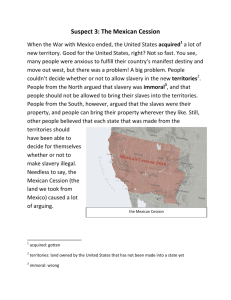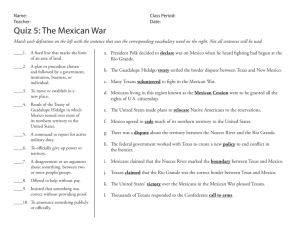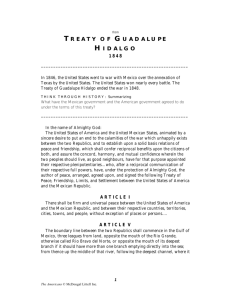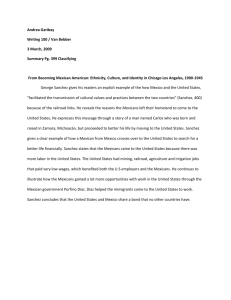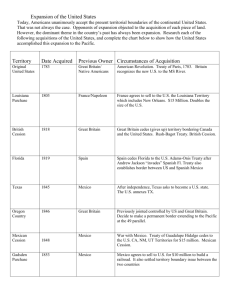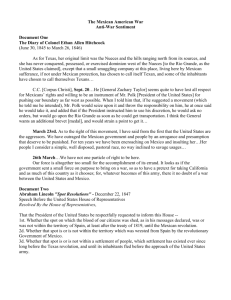Treaty of Guadalupe Hidalgo - UC Berkeley History
advertisement
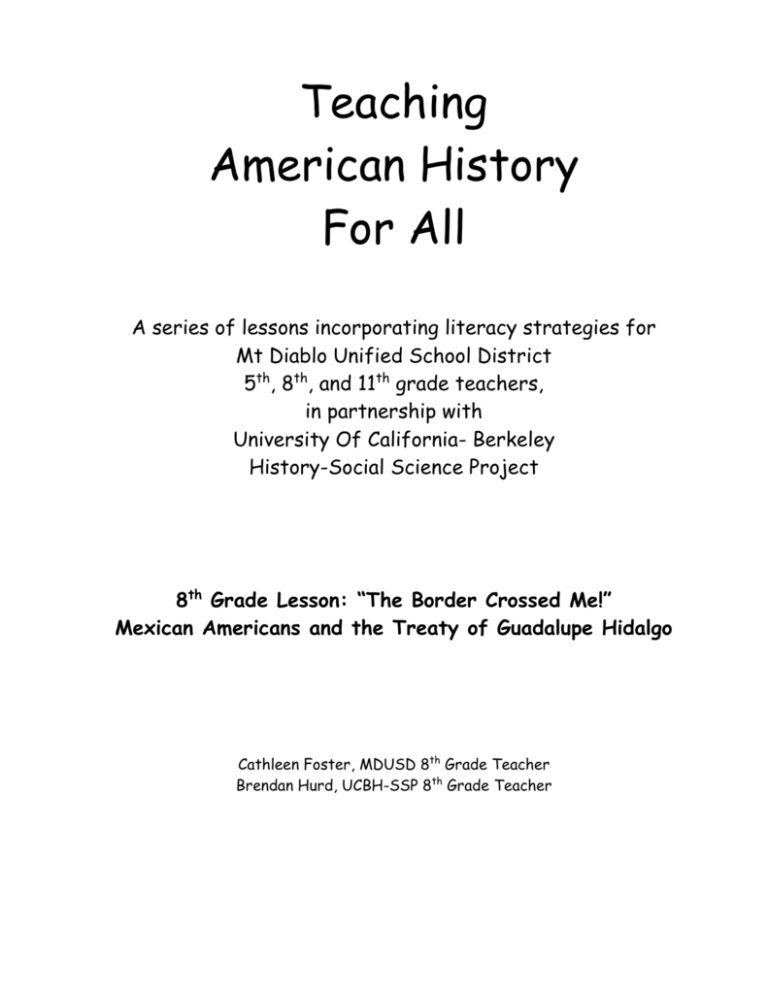
Teaching American History For All A series of lessons incorporating literacy strategies for Mt Diablo Unified School District 5th, 8th, and 11th grade teachers, in partnership with University Of California- Berkeley History-Social Science Project 8th Grade Lesson: “The Border Crossed Me!” Mexican Americans and the Treaty of Guadalupe Hidalgo Cathleen Foster, MDUSD 8th Grade Teacher Brendan Hurd, UCBH-SSP 8th Grade Teacher 8th Teaching American History for All MDUSD/UCB H-SSP Grade Lesson: “The Border Crossed Us” Developed by: Cathleen Foster and Brendan Hurd Teaching American History Grant Focus Question: How did definitions of citizenship change from the 17th century to the 20th century? 8th Grade Year-long Focus Questions: How did federalism shape the roles of the national and state governments? How did the rights of citizens expand and contract during the 18th and 19th centuries? Unit Focus: Expanding West Unit Focus Question: How did the country expand West from 1800 to the mid-1800s? Unit Working Thesis: White Americans movement west from 1800 to the mid-1800s was a result of the belief in Manifest Destiny, the presence of economic incentives, and the ability to overcome many political and social challenges at the expense of Native Americans and Mexicans. Lesson Focus Question: How effective was the Treaty of Guadalupe Hidalgo in securing the rights of Mexicans living in the territory of the Mexican Cession? Lesson Working Thesis: The United States Government made several promises to the Mexican people who lived within the borders of the Mexican Cession to protect their property and legal rights. However, these promises were not upheld in the years following, and the expensive legal battles of the Mexican-Americans proved to be ineffective. 2 Reading Strategy: 1. Chapter 10 Section 3 (p.323): Treaty of Guadalupe Hidalgo. Chronological Chart. 2. Treaty of Guadalupe Hidalgo: Article 8. Functional Grammar Chart that separates out the verb phrases in a particularly difficult piece of text. The true focus of the activity is making the treaty accessible to all readers. 3. El Clamor Público: Cause and Effect Chart showing the broken promises made by the treaty. Writing Strategy: Evidence Selection Worksheet Suggested Amount of Time: One to two days. Textbook: Deverell, William and White, Deborah Gray. United States History: Independence to 1914. Orlando, Florida: Holt, Rinehart and Winston., 2006, Chapter 10: Expanding West page 323 Other Resources: Treaty of Guadalupe Hidalgo: The Avalon Project at Yale University http://www.yale.edu/lawweb/avalon/diplomacy/mexico/guadhida.htm El Clamor Público, August 2, 1856: From Major Problems in Mexican American History edited by Zaragosa Vargas. Houghton Mifflin Company. 1999. Also available through the University of Southern California Libraries. Context of the lesson in the unit: The class should be familiar with the causes and progression of the Mexican American War. The lesson addresses Anglo American settlement of the Southwest after the war and the California Gold Rush. Since the Gold Rush is covered later in the textbook, the instructor will be required to provide some background information for the students. Concept of citizenship embedded in the lesson: This lesson provides content about minority groups in the American Southwest struggling for equal citizenship rights. Even though on paper they were guaranteed property rights and equal access to the legal system, in reality the new Mexican-American citizens saw their rights diminished under the U.S. control. 3 Lesson Procedures: Day One: 45 minutes 1. Review the Mexican-American War. This may include the causes of the war, the major battles and perhaps brief details on the Treaty of Guadalupe Hidalgo and the Mexican Cession from an earlier lesson. 2. Introduce focus question: Focus the students on the after effects of the Mexican American War on the lives of Mexicans within the Mexican Cession. 3. Textbook Chapter 10, Section 3, page 323 Cause and Effect Reading Strategy: Introduce the concept of a cause and effect chart if the students have never worked with one before. Read the three paragraphs of text entitled: American Settlement in the Mexican Cession and Agreements and Payments with the students as a class. Directly after reading the first paragraph go to the first section of the chart. Have students either copy directly or paraphrase the answer for the effect column. After completing the third paragraph have them complete the second section of the chart, again with the option of paraphrasing. The four questions that follow guide the students through the treaty and toward understanding the importance of property rights for citizens, especially once their territory has been seized by a foreign government. 4. With the next cause and effect chart the students should be able to work more independently, this can be done in class or at home. The goal of these questions is to guide the students through the legal struggles the Mexicans faced with the U.S. government. Day Two: 45 minutes 1. Review the lesson from the last two days. Remind the students of the focus question, ask the students to predict how the Treaty of Guadalupe Hidalgo was essential to the way the Mexicans would be treated by the United States government. Prompt the students with a reminder that a treaty is a deal between nations. Possible question: “What would Mexico demand as guaranteed rights for their former citizens?” After the students predict, tell students that they will take a closer inspection of the actual text of the treaty to look for these guarantees of citizenship. 4 2. Treaty of Guadalupe Hidalgo Functional Grammar handout: Student volunteers or the instructor read the text of Article 8 of the treaty out loud. The students fill in the action words column either together as a class or as individuals. There are questions in the right column to anticipate some of the obstacles students will face with this text, but comprehension may require more teacher guidance than just these questions. Encourage students to paraphrase the meaning and then confirm the correct interpretation. There are four questions at the end of this activity that may require the instructor to guide the discussion. These questions guide the students to the importance of the treaty in protecting property rights. 3. El Clamor Público Chronology Passage Organization Strategy: To cap off this instruction of the basics of the legal struggles of the Mexican-Americans, the students will read a newspaper editorial from the Mexican-American view point. Point out that this was written eight years after the treaty was signed. Have student volunteers read the editorial out loud and then give instruction on what time markers are and how to complete the chronology activity. These directions are on the handout. Use this time to point out that historians often use this passage level organization, emphasizing that it is key to taking good notes and remembering time order of events. The questions that follow this activity direct the students to notice the bias in the language and to clarify the process by which the Mexican-Americans struggled to maintain their property rights and citizenship. 4. Writing Strategy: In the culminating activity for this lesson, students will produce an analytical paragraph examining how Mexican Americans living in the Mexican Cession lost their property rights after the Mexican-American War. Since this lesson takes place roughly halfway through the school year, the writing process is still heavily scaffolded. Instructors should adjust the scaffolding to meet their students’ ability and experience with analytical writing. Discuss the writing prompt and expectations. Answer any questions students may have about the assignment. Working individually, in pairs, or as a whole class, have students choose the evidence which best supports the provided thesis. 5 Distribute the paragraph outline worksheet. Instruct students to fill in the provided thesis, and the evidence they have chosen to support the thesis. As a whole class, discuss which pieces of evidence students chose, and why. Conduct a structured academic discussion concerning the ramifications of this evidence. Working individually or in pairs, have students complete the analysis section of the paragraph outline. Be sure to remind them that this is their chance to explain why the evidence they chose is important. For homework, students will write a final draft version, using their paragraph outline form. History-Social Science Content Standards: 8.8. Students analyze the divergent paths of the American people in the West from 1800 to the mid-1800s and the challenges they faced. 6. Describe the Texas War for Independence and the Mexican-American War, including territorial settlements, the aftermath of the wars, and the effects the wars had on the lives of Americans, including Mexican Americans today. Historical and Social Sciences Analysis Skills: Chronological and Spatial Thinking 1. Students explain how major events are related to one another in time. Research, Evidence, and Point of View 4. Students detect the different historical points of view on historical events and determine the context in which the historical statements were made (the questions asked, sources used, author's perspectives). Historical Interpretation 5. Students understand and distinguish cause, effect, sequence, and correlation in historical events, including the long-and short-term causal relations. 6 Reading/Language Arts Content Standards: Comprehension and Analysis of Grade-Level-Appropriate Text 2.3 Find similarities and differences between texts in the treatment, scope, or organization of ideas. 1.0 Writing Strategies Organization and Focus 1.1 Create compositions that establish a controlling impression, have a coherent thesis, and end with a clear and well-supported conclusion. 1.3 Support theses or conclusions with analogies, paraphrases, quotations, opinions from authorities, comparisons, and similar devices. 7 Name Period Date Chapter 10: Expanding West Section 3: The Mexican-American War Page 323: American Settlement in the Mexican Cession The war ended after Scott took Mexico City. In February 1848, the United States and Mexico signed the Treaty of Guadalupe Hidalgo, which officially ended the war and forced Mexico to turn over much of its northern territory to the United States. Known as the Mexican Cession, this land included the present-day states of California, Nevada, and Utah. In addition, it included most of Arizona and New Mexico and parts of Colorado and Wyoming. The United States also won the area claimed by Texas north of the Rio Grande. The Mexican Cession totaled more than 500,000 square miles and increased the size of the United States by almost 25 percent. Agreements and Payments In exchange for this vast territory, the United States agreed to pay Mexico $15 million. In addition, the United States assumed the claims of more than $3 million held by American citizens against the Mexican government. The treaty also addressed the status of Mexicans in the Mexican Cession. The treaty provided that they would be “protected in the free enjoyment of their liberty and property, and secured in the free exercise of their religion.” The Senate passed the treaty in March 1848. After the war with Mexico, some Americans wanted to guarantee that any southern railroad to California would be built completely on American soil. James Gadsden, U.S. minister to Mexico, negotiated an important agreement with Mexico in December 1853. Under the terms of the Gadsden Purchase, the U.S. government paid Mexico $10 million. In exchange, the United States received the southern parts of what are now Arizona and New Mexico. With this purchase, the existing boundary with Mexico was finally fixed. What did each side gain in the Treaty of Guadalupe Hidalgo? Cause Effect [Because] In February 1848, the United States and Mexico signed the Treaty of Guadalupe Hidalgo. Mexico was forced to… [Because] After the war with Mexico, some Americans wanted to guarantee that any southern railroad to California would be built completely on American soil. 8 In this cause and effect chart, summarize the content from the text. Cause Effect [Because] Mexico agreed to the Treaty of Guadalupe Hidalgo and the Gadsden Purchase The United States gained… [Because] The United States gained so much Mexican Territory Mexico received… Mexican citizens received… [Because] Mexican Citizens in the Mexican Cession gained U.S. citizenship The United States promised… 1. Why were the rights protected by the treaty so important to the Mexicans living in the Mexican Cession? What could happen if these rights were not protected? 9 Chapter 10: Expanding West Section 3: The Mexican-American War Page 323: American Settlement in the Mexican Cession The war ended after Scott took Mexico City. In February 1848, the United States and Mexico signed the Treaty of Guadalupe Hidalgo, which officially ended the war and forced Mexico to turn over much of its northern territory to the United States. Known as the Mexican Cession, this land included the present-day states of California, Nevada, and Utah. In addition, it included most of Arizona and New Mexico and parts of Colorado and Wyoming. The United States also won the area claimed by Texas north of the Rio Grande. The Mexican Cession totaled more than 500,000 square miles and increased the size of the United States by almost 25 percent. Agreements and Payments In exchange for this vast territory, the United States agreed to pay Mexico $15 million. In addition, the United States assumed the claims of more than $3 million held by American citizens against the Mexican government. The treaty also addressed the status of Mexicans in the Mexican Cession. The treaty provided that they would be “protected in the free enjoyment of their liberty and property, and secured in the free exercise of their religion.” The Senate passed the treaty in March 1848. After the war with Mexico, some Americans wanted to guarantee that any southern railroad to California would be built completely on American soil. James Gadsden, U.S. minister to Mexico, negotiated an important agreement with Mexico in December 1853. Under the terms of the Gadsden Purchase, the U.S. government paid Mexico $10 million. In exchange, the United States received the southern parts of what are now Arizona and New Mexico. With this purchase, the existing boundary with Mexico was finally fixed. Cause Effect [Because] In February 1848, the United States and Mexico signed the Treaty of Guadalupe Hidalgo The Mexican-American war officially ended; Mexico turned over much of its northern territory to the United States [Because] After the war with Mexico, some Americans wanted to guarantee that any southern railroad to California would be built completely on American soil. The Gadsden Purchase : Mexico received $10 million and the U.S. received the southern parts of what are now Arizona and New Mexico. 10 In this cause and effect chart, summarize the content from the text. Cause Effect [Because] Mexico agreed to the Treaty of Guadalupe Hidalgo and the Gadsden Purchase The United States gained…Present-day California, Nevada, Utah, most of Arizona and New Mexico, parts of Colorado and Wyoming [Because] The United States gained so much Mexican Territory Mexico received…$10 million payment, $3 million in excused debts [Because]Mexican Citizens in the Mexican Cession gained U.S. citizenship Mexican citizens received… rights of citizenship The United States promised… that they would be “protected in the free enjoyment of their liberty and property, and secured in the free exercise of their religion.” 1. Why were the rights protected by the treaty so important to the Mexicans living in the Mexican Cession? What could happen if these rights were not protected? These rights are essential to citizenship. Without these rights they could loose their right to express themselves and to defend themselves and their property in court. They could be chased off their land and out of their homes without these protections. They would be forced to escape south into Mexico. 11 Name Period Date Chapter 10: Expanding West Section 3: The Mexican-American War Page 323: Surge of American Settlers After the Mexican-American War, a flood of Americans moved to the Southwest. American newcomers struggled against longtime residents to control the land and other valuable resources, such as water and minerals. Most Mexicans, Mexican-Americans, and Native Americans faced legal, economic, and social discrimination. As a result, they found it difficult to protect their rights. The Treaty of Guadalupe Hidalgo promised to protect Mexican-American residents’ property rights. Yet differences between Mexican and U.S. land laws led to great confusion. The U.S. government often made Mexican-American landowners go to court to prove that they had titles to their land. Landowners had to pay their own travel costs as well as those of witnesses and interpreters. They also had to pay attorneys’ and interpreters’ fees. These legal battles often bankrupted landowners. New settlers also tended to ignore Mexican legal concepts, such as community property or community water rights. Cause Effect A flood of Americans moved to the American newcomers struggled against Southwest longtime to control the 1. 2. 3. Most Mexicans, Mexican Americans, and they found it difficult to protect their rights. Native Americans faced , economic, and discrimination differences between... led to great confusion The U.S. government often made Mexican American landowners go to to prove that they had titles to their . Landowners had to pay their own travel costs as well as those of witnesses and interpreters. They also had to pay attorneys’ and interpreters’ fees. Landowners had to pay their own travel costs as well as those of witnesses and interpreters. They also had to pay attorneys’ and interpreters’ fees. These legal battles ... 12 1. Why did the new settlers want to control the water? 2. Why was there confusion when Mexican-Americans tried to defend their property rights with documents issued by the Mexican government? 3. Why were rich landowners better able to defend their land from the new comers? 4. Many Mexican land grants contained thousands of acres, and the land was shared by many families for farming and grazing cattle. Often there were no fences or property markers defining which family controlled what land. Why would these details become legal problems once Anglo Americans arrived? (Be careful, this answer is not in the text). 13 Name KEY KEY KEY KEY Period Date Chapter 10: Expanding West Section 3: The Mexican-American War Page 323: Surge of American Settlers After the Mexican-American War, a flood of Americans moved to the Southwest. American newcomers struggled against longtime residents to control the land and other valuable resources, such as water and minerals. Most Mexicans, Mexican-Americans, and Native Americans faced legal, economic, and social discrimination. As a result, they found it difficult to protect their rights. The Treaty of Guadalupe Hidalgo promised to protect Mexican-American residents’ property rights. Yet differences between Mexican and U.S. land laws led to great confusion. The U.S. government often made Mexican-American landowners go to court to prove that they had titles to their land. Landowners had to pay their own travel costs as well as those of witnesses and interpreters. They also had to pay attorneys’ and interpreters’ fees. These legal battles often bankrupted landowners. New settlers also tended to ignore Mexican legal concepts, such as community property or community water rights. Cause a flood of Americans moved to the Southwest Most Mexicans, Mexican Americans, and Native Americans faced legal, economic, and social discrimination differences between Mexican and U.S. land The U.S. government often made Mexican American landowners go to court to prove that they had titles to their land Landowners had to pay their own travel costs as well as those of witnesses and interpreters. They also had to pay attorneys’ and interpreters’ fees. Effect American newcomers struggled against longtime residents to control the land and other valuable resources, such as water and minerals. they found it difficult to protect their rights. led to great confusion Landowners had to pay their own travel costs as well as those of witnesses and interpreters. They also had to pay attorneys’ and interpreters’ fees. These legal battles often bankrupted landowners 14 1. Why did the new settlers want to control the water? Water was essential for farming in the arid southwest. By damning a water supply and using it for irrigation you would take water away from your neighbors. 2. Why was there confusion when Mexican-Americans tried to defend their property rights with documents issued by the Mexican documents? The Mexican laws were written differently from American laws. They were written in a different language and emphasized different details. 3. Why were the rich landowners better able to defend their land from the new comers? The rich landowners were best able to defend their land because they could afford the legal defense, the interpreters and the travel expenses. The poor were not able to. 4. Many Mexican land grants contained thousands of acres and the land was shared by many families for farming and grazing cattle. Often there were no fences or property markers defining which family controlled what land. Why would these details become legal problems once Anglo Americans arrived? Anglo settlers would move into any land that was not designated by property markers and start farming and grazing without permission. When a case came to court it was difficult to prove property rights without property markers. Finally, American law did not honor communal property as it did individual holdings. 15 Name Period Date The Treaty of Guadalupe Hidalgo ARTICLE VIII In the said territories [previously belonging to Mexico, and which remain for the future within the limits of the United States], property of every kind, now belonging to Mexicans not established there, shall be inviolably respected. The present owners, the heirs of these, and all Mexicans who may hereafter acquire said property by contract, shall enjoy with respect to it guarantees equally ample as if the same belonged to citizens of the United States. Time marker/ connector words Who (subject) Participants In the said territories property of every kind, now belonging to Mexicans not established there The present owners, the heirs of these, and all Mexicans who may hereafter acquire said property by contract Action words (verbs/ verb phrases) Who, What, Where Message Questions or conclusionsWhat connections can you make from this information? Does a Mexican have to live on their property to own it? with respect to it guarantees [that are] equally ample What does “it” refer to? What root words do you recognize in the word “inviolably”? What is an heir? Can Mexicans buy property? How? as if the same [property] to citizens of the United States 1. What territories is the treaty talking about when it says “in said territories”? 2. How did the United States promise to treat all Mexican property holders? 3. Why did the Mexican government want these guarantees written into the treaty? 4. What kind of “guarantees” or promises does a government give to the property holders within its borders? 17 Name KEY KEY KEY KEY The Treaty of Guadalupe Hidalgo ARTICLE VIII In the said territories [previously belonging to Mexico, and which remain for the future within the limits of the United States], property of every kind, now belonging to Mexicans not established there, shall be inviolably respected. The present owners, the heirs of these, and all Mexicans who may hereafter acquire said property by contract, shall enjoy with respect to it guarantees equally ample as if the same belonged to citizens of the United States. Time marker/ Who (subject) Action words Who, What, Where Questions or conclusionsconnector words Participants (verbs/ verb Message What connections can you phrases) make from this information? In the said property of shall be Does a Mexican have to live on territories every kind, now inviolably their property to own it? belonging to respected Mexicans not No, they do not have to be established “established there”. there The present shall enjoy with respect to it guarantees What does “it” refer to? owners, [that are] equally ample The property. the heirs of these, What is an heir? A person who and all Mexicans inherits the property. who may hereafter What root words do you acquire said recognize in the word property by “inviolably”? contract Can Mexicans buy property? Yes, they can buy by contract. as if the same belonged to citizens of the United [property] State 1. What territories is the treaty talking about when it says “in said territories”? The territories include all of the lands in the Mexican Cession. 2. How did the United States promise to treat all Mexican property holders? The U.S. would treat all Mexican property holders as equal to all U.S. citizens. 3. Why did the Mexican government want these guarantees written into the treaty? The Mexican government wanted to protect its former citizens from being abused by the U.S. government or Anglo settlers. 4. What kind of “guarantees” or promises does a government give to the property holders within its borders? A government promises to protect the property of its citizens from theft, damage or destruction. This is why the government provides police and fire protection. This is also why the courts see many cases regarding disputes between neighbors. 19 Name: Period: El Clamor Público Date: El Clamor Público was the first Spanish-language newspaper in California after the Mexican-American War. It was founded by Francisco P. Ramirez, a 19-year-old printer. 233 issues were published between July 1855 and August 1859. The paper had strong political views generally in support of the Mexicanos. While it often dealt with political and legal issues, the newspaper also included poetry and literature. It was distributed as far north as San Francisco. ~ Gathered from the University of Southern California Libraries. http://www.usc.edu/libraries/collections/el_clamor_publico/ El Clamor Público, August 2, 1856: When California came to be an integral part of the Northern Republic [the United States], many citizens remained to enjoy their properties that they had just obtained from Mexico via cession, sale, etc. These people from the mere fact of having remained [on their property] obtained the same rights and privileges of American citizens. But no sooner had order been re-established when the National Congress dictated a law that established a commission to revise land titles. This measure cost uncountable expenses for the property owners and many had spent all their fortune to defend their property. Before their titles were approved, they had to make two or three trips to Washington and finally their labors and watchfulness yield them nothing. After three years of continuous litigation most of the landowners are ruined. At the end, not satisfied with having uprooted from the hands of the Californians and Mexicans their possessions, the last session of the Legislature passed a law whose object it was to declare as public property all California land, except that which had a government title. Chronology Activity: Many words in this passage are “time markers”. These words or phrases denote the passing of time between events. Go back through the text and write exactly what comes after each time marker or paraphrase the event in your own words. When… But no sooner… when… Before… finally … After three years … At the end,… 1. What happened to the Mexicanos and the Californios according to this article? 2. What group or entity uprooted the Mexicanos and the Californios from their property? 3. What words in this passage demonstrate that this author has a biased opinion toward the Mexicanos and Californos and against the United States Congress? 4. Why were the Americans and the U.S. government able to take so much land from the Mexicanos and Californios if they were considered citizens under the terms of the treaty? 21 Name: KEY KEY KEY KEY KEY Period: Date: El Clamor Público El Clamor Público was the first Spanish-language newspaper in California after the Mexican-American War. It was founded by Francisco P. Ramirez, a 19-year-old printer. 233 issues were published between July 1855 and August 1859. The paper had strong political views generally in support of the Mexicanos. While it often dealt with political and legal issues, the newspaper also included poetry and literature. It was distributed as far north as San Francisco. ~ Gathered from the University of Southern California Libraries. http://www.usc.edu/libraries/collections/el_clamor_publico/ El Clamor Público, August 2, 1856: When California came to be an integral part of the Northern Republic [the United States], many citizens remained to enjoy their properties that they had just obtained from Mexico via cession, sale, etc. These people from the mere fact of having remained [on their property] obtained the same rights and privileges of American citizens. But no sooner had order been re-established when the National Congress dictated a law that established a commission to revise land titles. This measure cost uncountable expenses for the property owners and many had spent all their fortune to defend their property. Before their titles were approved, they had to make two or three trips to Washington and finally their labors and watchfulness yield them nothing. After three years of continuous litigation most of the landowners are ruined. At the end, not satisfied with having uprooted from the hands of the Californians and Mexicans their possessions, the last session of the Legislature passed a law whose object it was to declare as public property all California land, except that which had a government title. Chronology Activity: Many words in this passage are “time markers”. These words or phrases denote the passing of time between events. Go back through the text and write exactly what comes after each time marker or paraphrase the event in your own words. When…California was taken over by the U.S., many folks stayed on with the same rights as U.S. citizens But no sooner… had law and order been re-established when…Congress passed a law revising land titles. Before… landowners could get their titles approved they had to go to DC finally …their effort gave them nothing. After three years …of lawsuits, the landowners were broke. At the end,… Congress passed another law that converted all land not officially under title as government land. 22 1. What happened to the Mexicanos and the Californios according to this article? Their land was taken away. 2. What group or entity uprooted the Mexicanos and the Californios from their property? The U.S. government. 3. What words in this passage demonstrate that this author has a biased opinion toward the Mexicanos and Californos and against the United States Congress? When California came to be an integral part of the Northern Republic [the United States], many citizens remained to enjoy their properties that they had just obtained from Mexico via cession, sale, etc. These people from the mere fact of having remained [on their property] obtained the same rights and privileges of American citizens. But no sooner had order been re-established when the National Congress dictated a law that established a commission to revise land titles. This measure cost uncountable expenses for the property owners and many had spent all their fortune to defend their property. Before their titles were approved, they had to make two or three trips to Washington and finally their labors and watchfulness yielded them nothing. After three years of continuous litigation most of the landowners are ruined. At the end, not satisfied with having uprooted from the hands of the Californians and Mexicans their possessions, the last session of the Legislature passed a law whose object it was to declare as public property all California land, except that which had a government title. 4. Why were the Americans and the U.S. government able to take so much land from the Mexicanos and Californios if they were considered citizens under the terms of the treaty? The Mexicanos and Californios were not well represented in Congress. Anglo Americans were able to use the legal system to their advantage. Anglos could buy a piece of property locally or simply take possession of land by squatting on it, but defending a Mexican land grant title had to be done at the national capital in D.C.. 23 8th Grade “The Border Crossed Me” Lesson Writing Prompt Background: The Treaty of Guadalupe Hidalgo signaled the official end of the MexicanAmerican War in 1848. It promised that Mexicans who owned property in the area ceded to the United States would be protected, just as if they were United States citizens. However, this promise was not realized. Question: How did Mexicans living in the Mexican Cession lose their property rights? Expectations: Write a paragraph with a thesis which states your main idea and position. Support your topic sentence with at least three pieces of evidence. Your analysis should explain why the evidence is significant (important). End with a conclusion that restates your thesis in different words. Possible thesis: Mexicans living in the Mexican Cession lost their property rights when the United States government ignored the promises made by the Treaty of Guadalupe Hidalgo. 24 8th Grade Choosing Evidence Read the thesis statement below and circle the three best pieces of supporting evidence. Question: How did Mexicans living in the Mexican Cession lose their property rights? Possible thesis: Mexicans living in the Mexican Cession lost their property rights when the United States government ignored the promises made by the Treaty of Guadalupe Hidalgo. 1. Soon after the treaty was signed, Congress passed a law revising land titles, which stripped many Mexicans of their property. 2. The Mexican Cession increased the size of the United States by 25 percent. 3. Many Americans moved into the newly acquired territory. 4. The only recourse for Mexicans who had lost their land was long, expensive court battles. 5. American settlers, who believed they had the right to take any land they wanted, ignored the terms of the Treaty of Guadalupe Hidalgo and became squatters on land owned by Mexicans. 6. Americans’ belief in Manifest Destiny made them think they were superior to Mexicans and had more right to the land. 25 8th Grade Choosing Evidence Read the thesis statement below and circle the three best pieces of supporting evidence. Question: How did Mexicans living in the Mexican Cession lose their property rights? Possible thesis: Mexicans living in the Mexican Cession lost their property rights when the United States government ignored the promises made by the Treaty of Guadalupe Hidalgo. 1. Soon after the treaty was signed, Congress passed a law revising land titles, which stripped many Mexicans of their property. 2. The Mexican Cession increased the size of the United States by 25 percent. 3. Many Americans moved into the newly acquired territory. 4. The only recourse for Mexicans who had lost their land was long, expensive court battles. 5. American settlers, who believed they had the right to take any land they wanted, ignored the terms of the Treaty of Guadalupe Hidalgo and became squatters on land owned by Mexicans. 6. Americans’ belief in Manifest Destiny made them think they were superior to Mexicans and had more right to the land. 26 Name: ___________________ Mexican-Americans in the Mexican Cession Paragraph Outline Question: How did Mexicans living in the Mexican Cession lose their property rights? Thesis statement: Mexicans living in the Mexican Cession lost their property rights when the United States government ignored the promises made by the Treaty of Guadalupe Hidalgo. Evidence 1: ____________________________________________________________________ ____________________________________________________________________ ____________________________________________________________________ Evidence 2: ____________________________________________________________________ ____________________________________________________________________ ____________________________________________________________________ Evidence 3: ____________________________________________________________________ ____________________________________________________________________ ____________________________________________________________________ Analysis (So What?): The disparity between the promises made in the Treaty of Guadalupe Hidalgo and the reality of its enforcement show that the American government ________ ____________________________________________________________________ ____________________________________________________________________ Concluding statement: ____________________________________________________________________ ____________________________________________________________________ ____________________________________________________________________ 27
